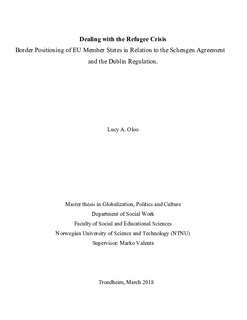| dc.description.abstract | In early summer of 2015, the number of refugees arriving in Europe from war-tone Syria heightened immensely as it attracted a flow of refugees from other war-tone and politically unstable regions. The large unprecedented inflow led to intense pressure and disagreement among some EU Member States over how to uniformly deal with the situation. The lack of agreement prompted member states to deal with the refugees by establishing distinct border positioning from each other as individual national states and as transit and destination countries. The distinct positioning was noticeably a challenge to the Schengen Agreement and the Dublin Regulation; two of EU’s common immigration policies, meant for providing uniform ways for dealing with non-EU citizens entering Europe.
Using a qualitative research approach based on data collected from semi-structured interviews with migration experts, and various relevant reports and studies, this thesis aims at finding out how some EU Member States positioned themselves distinctively from each other in relation to the Schengen Agreement and the Dublin Regulation when dealing with the refugees at their borders. The study focuses on the periodic development of the refugee crisis from when the situation escalated in early summer of 2015, until the Western Balkan route (a significant fast refugee transit route) was officially closed in March 2016 (Lilyanova 2016: 2). The study considers this period relevant since the closure of this route triggered a chain of events that stipulated response from several other European countries. The thesis examines the distinct positioning of member states as individual national states and as transit and destination countries. The study further explores some of the motives of the distinct border positioning, and the influence of the distinct positioning on the flows of refugees. Greece, Croatia, Denmark, and Germany are selected as the primary study areas. However, the study strategically includes other countries within and outside the EU as illustrative examples. Alongside relevant previous studies, the analysis of the thesis is developed around the migration system theory, the theory of policy convergence and its mechanism of harmonization and regulatory competition, international relations theory of realism, and the push-pull theory. The findings in the study affirm that member states resolved to distinct positioning that included the implementation of border strategies as individual national states and as transit and destination countries. Evidently, the border positioning disharmonized with the Schengen Agreement and the Dublin Regulation. Moreover, the findings reveal that some member states resolved to distinct positioning to ease the large numbers of refugees arriving at their borders, and in addition, out of the concern over the economic impact that the large influx would have in their countries. The findings ultimately indicate that the kind of border measures adapted by member states may influence the flows of refugees arriving at the borders. | nb_NO |
